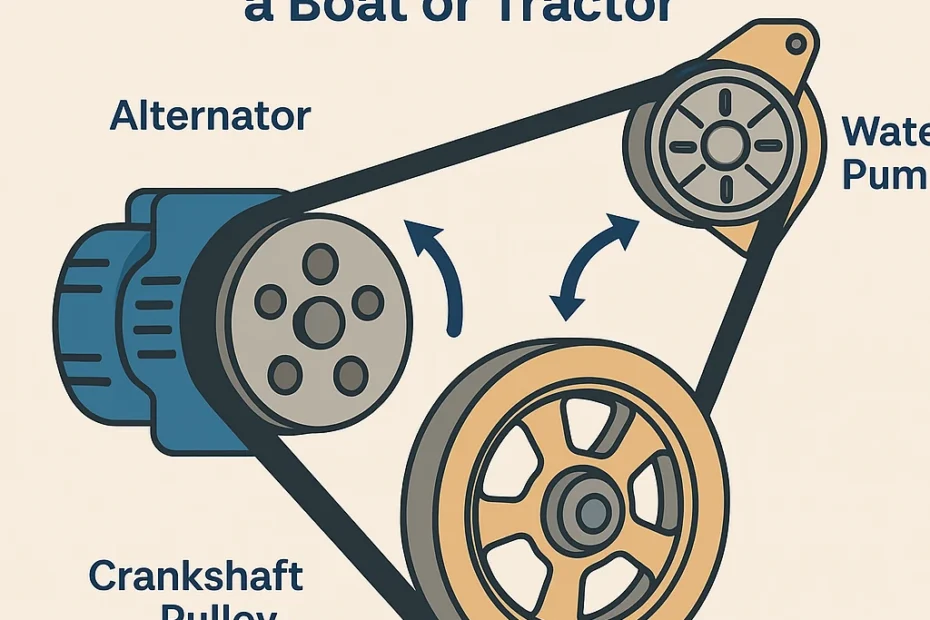Introduction
Out on the open water, the last thing you want is a mechanical failure. One small but mighty component that’s often overlooked? The alternator belt. If it’s worn and you ignore it, you could be facing anything from power loss to complete breakdown, far from the shore. Let’s unpack exactly what happens if you don’t replace a worn marine alternator belt.
What is a Boat Alternator Belt?
Purpose and Function
The alternator belt on a boat connects the engine’s crankshaft pulley to the alternator, allowing it to generate electricity. This powers everything from your bilge pump and GPS to navigation lights and radio — and more importantly, it keeps the battery charged.
How It Works in a Marine Engine System
In marine engines, the alternator belt may also run other critical components like the water pump or even power-assisted steering. A single belt failure could cascade into full system loss.
Signs Your Boat’s Alternator Belt is Worn
Visual Wear and Tear
If the belt looks cracked, brittle, glazed, or unevenly worn, it’s past its prime. Salt air and constant moisture accelerate this wear.
Squealing or Chirping Sounds
High-pitched noises at engine start-up or during load changes are often due to slipping belts — a tell-tale warning sign.
Electrical Malfunctions or Power Loss
Dim cabin lights, erratic gauge readings, or a failing VHF radio can point to an alternator not spinning fast enough to keep up, often due to a worn belt.
The Risks of Ignoring a Worn Alternator Belt at Sea
Engine Shutdown While Underway
A broken belt can stop your alternator and, if it’s linked to your water pump, even lead to overheating. Your engine could seize — a nightmare if you’re miles offshore.
Battery Drain and Critical System Failure
Without a functioning alternator, your boat runs purely on battery reserve. Once it dies, say goodbye to GPS, radar, lights, bilge pumps, and comms — your safety net disappears.
Cooling System Compromise
Many marine engines rely on a belt-driven seawater pump. Lose the belt, lose the cooling, and you’re staring down engine overheating and potential fire risk.
Steering and Navigation Issues
If your vessel has hydraulic steering or advanced electronics tied to belt-powered systems, failure could make manoeuvring extremely difficult or impossible.
Damage to Other Engine Components
A bad belt may shred, causing debris to damage pulleys, sensors, or get sucked into intakes. Misalignment or added tension from an old belt can also wear bearings.
Long-Term Damage to Your Vessel
Engine Overheating and Internal Damage
Overheating from a failed belt can warp cylinder heads, blow gaskets, or even crack the engine block — a financial catastrophe for boat owners.
Increased Repair Bills
A £50 belt may cost you thousands if ignored. Think: towing, mechanic fees, and parts replacement — not to mention lost time and stress.
High Risk of Being Stranded
A failed alternator belt can leave you dead in the water. With no propulsion, power, or safety systems, your options quickly dwindle.
Can You Sail with a Worn Alternator Belt?
It’s technically possible for short trips, but not advisable. Every minute it runs, the risk of sudden failure increases. It’s not worth the gamble when the sea is unforgiving.
What Happens If It Snaps Mid-Voyage?
Expect instant electrical loss, possibly overheating, and a drained battery within minutes or hours. If the belt also drives the water pump, things escalate quickly, including engine lock-up.
Recommended Replacement Schedule for Marine Belts
Most marine belts should be inspected every 100 engine hours and replaced every 2–3 years, or at the first sign of wear. Check your engine manufacturer’s guidelines.
Cost of Replacing vs. Cost of Emergency Repairs
Task Approximate Cost (UK)
Belt Replacement £50 – £150
Marine Mechanic Call-Out £100 – £250+
Engine Overhaul £1000 – £3000+
Towing from Open Water £200 – £600+
A quick swap before setting sail can save serious money and stress.
Preventive Maintenance for Marine Alternator Belts
Routine Checks Before Departure
Always inspect the belt before trips. Look for cracks, frays, slack, or shiny patches that signal wear.
Listening for Unusual Sounds
Squealing or chirping is a common early warning. Don’t ignore it.
Replacing on a Preventive Basis
Don’t wait until failure. Proactive replacement is a small cost for big peace of mind.
DIY vs Marine Mechanic: What’s Safer?
If you know your engine and have the right tools, a DIY replacement is doable. But for tight spaces or complex setups, a marine tech ensures proper tension and alignment, and often spots other issues while at it.
Final Thoughts
The alternator belt on your boat isn’t just a piece of rubber — it’s a lifeline. Let it wear too far, and you risk not just your engine but your safety. Replace it early, sail with confidence, and keep your voyages smooth and stress-free.
